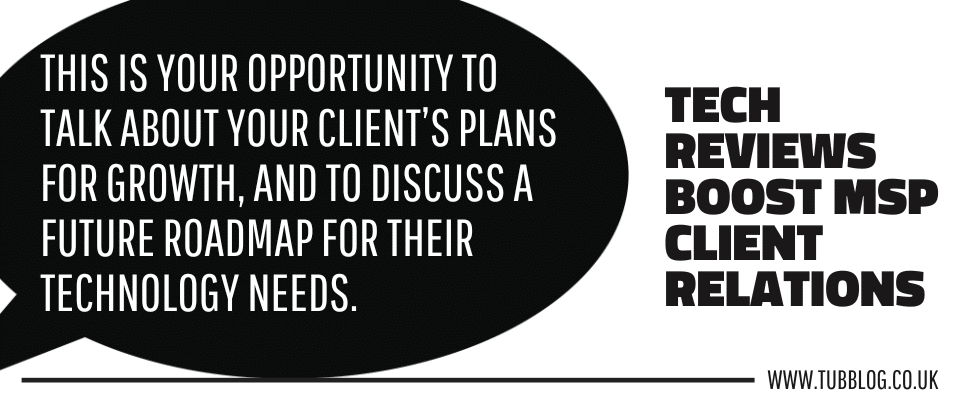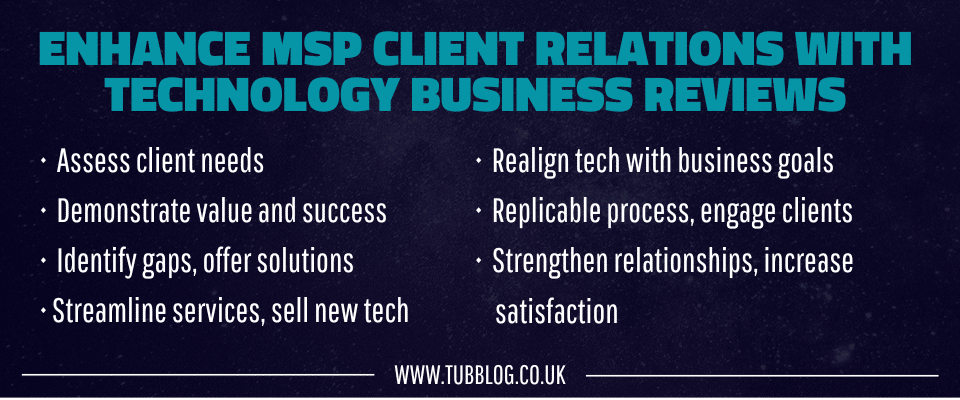It’s hard work starting a business. And even when you have it up and running, the work doesn’t stop there.
Aside from working on your business to find new clients and scale up, you should also regularly review your business in at least these three key areas:
- The efficiency of your operations
- Profitability
- Customer satisfaction
As an MSP (managed service provider), you can cover most of these by holding regular business reviews with your SME (small and medium enterprise) clients.
Doing this allows you to strategically plan for the future, while strengthening business relationships with your customers.
The Power of Metrics – Underpinning the Need for Business Reviews
Reporting on your operations goals allows you to measure whether you’re underperforming or not. The same goes for your profitability analysis of your customers, which can be done from data from your professional services automation (PSA) tool, or from comparing helpdesk ticket volumes and licencing to client sales & revenue.
There are even ways to measure your customer satisfaction, or C-SAT as it’s often called. However, metrics will only highlight issues. Carrying out the necessary remedial actions can either take the form of internal efficiency savings, or you can review your service agreements with your clients.
And the best ways for MSPs to do this is to conduct regular one-on-one technical business reviews (TBRs).
What is a Technical Business Review?
A technical business review gives you the opportunity to refocus your energy on making improvements that realign your services to suit your customer’s needs.
Reviews that are scheduled regularly with your customers builds trust with them. Furthermore, it can lead on to more opportunities to sell them solutions that fit their ever-evolving business needs.
As an MSP owner, it’s vital you grasp the importance of conducting TBRs. But it’s just as vital for your clients to be aware of what a great opportunity these are for them too.
They give your customers the chance to realign the services you provide to better fit their business.
That’s why these should be included in your agreement, and given a monetary value. By giving it a value, you show it’s worth something to them. It’s often been said that if something is free of charge, it means it’s worthless!
TBRs Versus QBRs
QBRs (Quarterly Business Reviews) are similar to TBRs except they’re set to occur every three months.
According to Nigel Moore, founder of the Tech Tribe, setting reviews on a fixed three-monthly schedule is counterintuitive for most MSPs. No one-size-fits-all, and therefore in defining a rigid system, you’re setting them up to fail. Whereas conversely, a TBR allows you to set a frequency that suits both you and the client.
Others names for TBRs/QBRs include:
- Strategic Business Reviews
- Technology Alignment Assessments
- IT Future-Planning Meetings
- Business Realignment Meetings
The Benefits of Technical Business Reviews
Having regular one-on-one reviews with your clients provide a host of benefits, such as:
Planning for the Future
They help you to develop a future roadmap for your clients in how you, as their technology partner, will meet their technology needs. Planning ahead allows both you and your clients to set a budget for what lies ahead, and prepare the way forward in terms of growth.
Educating Your Client
It’s our duty to educate our clients on the potential risks they may face in the future, if action is not taken now. And we can also inform them of the opportunities in emerging tech that they may want to invest in, to get a competitive edge.
A Better Understanding of Your Client’s Business
Conversely, the reviews can also reveal to us, the pressures and opportunities that are affecting their business. And as their technology partners, we need to think about what we need to do to better support them. Whether it’s investing in new tools and tech, or supporting them in other ways.
Building Trust with Your Client
Showing an interest in improving services for your clients inevitably elevates the relationships you have with them. Above being just a tech support contractor, you become a trusted partner. In other words, these reviews offer a chance to reaffirm your relationship with your client on the basis of the value you’re providing.
Improving Customer Satisfaction
Proving your success will lead to increased customer satisfaction. And satisfied customers are more likely to write glowing testimonials for you, or provide word-of-mouth referrals. Satisfied customers means lower retention rates, and reduced client churn.
Reducing Support Inefficiencies
If there’s a legacy system that’s costly to support, and prone to vulnerabilities, it could be an opportunity to sell the benefits of migrating or upgrading. Likewise, if there are any regularly repeated tickets – this is your chance to see how you can reduce them. Whether that’s using automation, self-service portals, producing knowledge base articles or finding another tool to bridge a gap.
Many of these benefits will almost certainly result in better working relationships with your clients, more sales for your MSP and greater satisfaction for everyone.
Before You Schedule a Technical Business Review
It’s important to remember that you should make TBRs about the client, not about you.
While review dates should be flexible to suit them, you should emphasise how essential they are keep their business up-to-date.
A pro tip for when you’re booking these reviews: Remind the client, two weeks before the next TBR is due, that they need to book in with you. Allowing them to book the meeting with you will solidify a time and date which they’re less likely to renege on or cancel. You can use an online booking system, such as Calendly to do this.
Make sure the right people are invited along to TBRs – if there’s technical questions to be asked on either side – make sure those key stakeholders are in the room.
Making a Record of Your Review
Recording the action points of a TBR allows for mutual accountability and serves as a reminder the next time you hold a review.
While you could just do all of this on a shared spreadsheet, or simply create tickets on your helpdesk system, there are other options that facilitate TBR management more effectively.
While you should always do your own due diligence when looking at TBR software, these three are definitely worth taking a look at:

Adopting the SMART-er Approach
Setting goals for yourself and your client can be difficult, and you don’t necessarily know what the goals may be until you hold your review meeting.
However, a great way to know if you’re setting the right kind of targets is to use the SMART framework:
S – Specific: Avoid vague targets that are open to interpretation if you can.
M – Measurable: Being able to quantify your goals means you can measure you progress.
A – Achievable: Make sure you’re not setting a target to fail if neither you or the client can meet the expectations.
R – Relevant: Ensure that you cover the essentials first. Where will you both see the most impact.
T – Time-Bound: Goals should have a deadline wherever possible.
To find out more about the SMART goal framework, career experts Indeed have a great guide about the subject here.
Structuring a Technical Business Review
A good Technical Business Review covers three stages:
- Recalling the observations & actions of the previous review
- Reporting on current progress & pain points
- Discussing future plans & concerns
Then finish up with a recap of points discussed and actions agreed.
1. Reviewing the Past
Take a look back at the previous review, or the contract if this is the first review.
Reflect on agreed actions and how you both met your obligations. Discuss what went well, and not-so-well, and how it can be improved for next time. Take note on how you can adapt your processes if required to be more effective in the future.
If you’re armed with the right metrics to back up your successes, this is an effective way of demonstrating your worth, and the value of these reviews, to your client.
2. Reporting on the Present
Next, you discuss any recent and current issues that are affecting your client.
Talk about where you are with current projects and unresolved issues. What are their frustrations and how could things be better aligned for their business.
Look through the high-level metrics that will be of interest to the client. However, you don’t need to drill down to the minutiae here. The purpose is to highlight how you can help your client, so there’s no need to go overboard in stating your case.
3. Discuss Plans for the Future
This is your opportunity to talk about your client’s plans for growth, and to discuss a future roadmap for their technology needs.
At a high level, this should include what their goals are for the next few years ahead. This includes any hardware or devices that may need to be purchased, as well as a review of any software licences that need to be renewed, replaced or migrated from older end-of-life tech.
This is your opportunity here to educate your clients about important news and new products that may be of interest to them. As their technology partner, you should impress upon them why you think a product may be right for them at this time, or for the future.
Agreeing a roadmap of objectives with the client means you can set targets and deadlines, factoring in any contingencies. This is to set out clearly what the obligations are for you and your client, making sure there are few surprises in the coming months ahead.
You can set realistic budget expectations too, reinforcing trust in your partnership.
Recap and Sign Off
As there’s a lot to cover in a meeting like this, it’s best to finish it off with a recap of what you’ve discussed and agreed, to avoid ambiguity. For posterity, both MSP and the client should sign the document, with a copy emailed across to your client.
Also, now is a good time to schedule when the next review will take place.
Finally remember to have an informal conversation about whether the client is happy with the progress. If they are, ask if they would be happy to refer you to similar businesses in their network. And are they willing to write you a review or testimonial for your website!
More Tips for Conducting TBRs
Although it looks like there is a lot to cover, it’s best to try and kept these meetings as brief as possible.
Make sure you have the agenda prepared for what you’re going to cover, and some metrics to back up your observations.
Give the client plenty of time to tell you their pain points, as it’s here you will find opportunities to show your value and ultimately increase your revenue.
Here are a few conversation starters for you:
- If there was one thing we could change for your business to make it easier, what would that be?
- I’ve noticed your team have logged a lot of calls about X is there anything we can do to educate your team to avoid these?
- What are your plans for growth over the next 18 months/3/5 years?
- What have we done recently that’s made things much easier for you?
Following Up After the Business Review Meeting
When you get back to the office, you’ll have a number of things to do.
Firstly, put in a reminder for yourself about the next TBR meeting, including to send a reminder to the client two weeks before the TBR is due.
Assign actions to the relevant member of your team to follow-up in more detail. For example, task your Sales Manager to follow up on potential new sales, Service Delivery Manager to follow-up on any tickets raised, etc.
Raise tickets for any work discussed at the meeting, as well as work resulting from evergreening, retiring end-of-line technology, etc.
If they wrote you a glowing testimonial for your website, or managed to secure a referral, make sure to send a handwritten thank you note and a gift to show how much you value their business.
And lastly, tweak your technology business review process if you feel it could do with a bit of polish. It’s likely that you’ll refine this process over time, and tailor it differently to suit each of your clients.
Conclusion
Technical Business Reviews are a way to assess if what you’re providing for your clients still reflects their needs. In holding them, you’re showing that you not only value the income their business provides, but their success too. Furthermore, it’s a chance for you to identify any gaps, and offer them solutions, effectively giving you the chance to justify an upsell to your clients.
For MSPs, it’s a chance to streamline existing services and potentially sell new technology solutions to their partners. For the SME clients, it’s an opportunity for them to realign the technology they’re paying for to better fit the direction of their business.
In the case of both parties, the end result is a stronger business relationship and greater satisfaction. Hopefully leading to increased profitability for both of your businesses.
In keeping your TBR process light and straightforward, it will be easier to replicate for multiple clients.
You’ll keep your client partners engaged and happy too, which will make future planning for your business much easier.
What has been your experience with business reviews? And if your MSP doesn’t use these, how do you keep your clients engaged and satisfied with your service? We’d love to hear from you in the comments.



















Comments